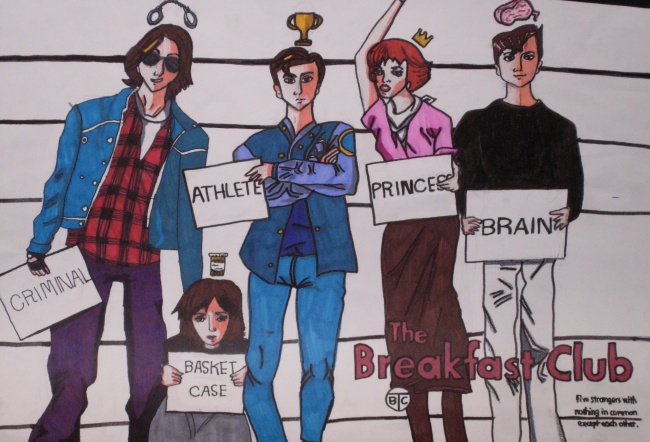Compulsory heterosexuality is a concept rarely questioned in contemporary society. This essay will not only discuss its heteronormative ideals with references to the expectations of gender and sexuality throughout a Western hegemonic culture, but will also highlight ways in which it has become normalised through discourse and social interaction. The question of whether or not structure overrides agency and aids to define an individual’s sexual behaviour or gender will be asked in turn. However, this essay’s argument states that in direct opposition to the essentialist perspective of sexuality, social constructionism acts to reinforce ideals of heteronormativity, and yet, serves to challenge these norms simultaneously through the construction of a metaphorical framework. Throughout this framework, agency can be found, but in order to display a sense of free will and free expression, certain guidelines must be adhered to.
Compulsory heterosexuality, or heterosexism, can simply be defined as the dominant norm for sexual orientation, thus to take on any other form of sexual orientation outside the norm is seen as a deviant act (Germov & Poole 2011, p.10). This means that all social interaction is filtered and seen through the lens of a heteronormative gaze. A common misconception, however, throughout Western society is that gender and biological sex are synonymous in meaning. This is not the case. Compulsory heterosexuality, within a post-modern patriarchal structure, has its origins deeply entrenched throughout modernity. As the clinical study of the body during this time took a reductionist approach to sexuality, its assignment of function to each appendage created the normative view that sexual organs were to be associated with human reproduction (Hawkes & Scott 2005, p.10). Reductionism is a word used to describe the minimisation of a phenomena to its most simplistic single form (Abercrombie, Hill & Turner 2006, p. 321) and this methodical practice is evident within the heternormative views of society. Therefore, seeing the world through this frame communicates the discourse that sexual behaviour is a result of our biological state. From this assumption, it can be deduced that, as a common misconception, it ‘helped to legitimate male dominance in a range of social settings’ (Hawkes & Scott 2005, p.10). As a result, this fuelled the normalisation of compulsory heterosexuality, and yet, it could be argued that norms are not subjected to determinism in society.
Biological sex is biologically determined, sexuality is altered in accordance to preference, and gender is a behavioural mode of being (Butler 2011). These three concepts are not substitutable. However, role expectations within Western culture have led people to trust in the belief that they must perform certain acts within certain structures to avoid conflict. For example, it is a commonly taken for granted view that females should act like girls and males should act like boys but this is not always the case. This avoidance of conflict can be seen to spur on emotions of shame, insecurity, or even fear, and therefore, encourages expressionistic silence. For example, research shows that in many English speaking countries, not excluding Australia, discrimination against homosexuality is discouraged and, at times, even illegal. Regardless of this, heterosexual men are shown to ignore homosexual desire in fear of being shunned by their peers (Richters & Rissel 2005, p.118). This is extremely problematic at the time of adolescence, when identity is at its most vulnerable through the unavoidable pressures of socialisation. This prejudice is evident in Australia, for instance, in which ‘bisexuality is not widely recognised as a valid sexual identity’ and, therefore, ‘not protected by discrimination legislation’ (Richters & Rissel 2005, p.119). In direct contention to this, research shows that ‘same-sex attraction or experience is reported by 9 per cent of men and 15 per cent of women’ (Richters & Rissel 2005, p.113). These are high numbers which are, for the most part, ignored. Therefore, compulsory heterosexuality seems to not only be put in place by popular discourse, but also shows to be enforced by the state and government. However, there is still hope that this patriarchal view of the world will shift but this will only occur when expectations and discourse through agencies of socialisation are altered (Connell 2005, p.23). This includes television, film, and magazines, however, agencies of socialisation aren’t just limited to materialistic devices; discourse can also be communicated and circulated through symbolic interactionism. Mead’s concept of symbolic interactionism places its emphasis on language and social interaction, as both are a means of developing a sense of self (Germov & Poole 2011, p.523).
Social constructionism refers to the social development of human characteristics based on the ‘idea that people actively construct reality’ though symbolic interactionism (Abercrombie, Hill & Turner 2006, p.521). Therefore, the outcome of meaning is not a result of nature but purely through the effects of social interaction. This makes meaning entirely subjective to context in nature. According to this method of viewing the world, gender and sexuality are both social constructs within society despite dominant discourses that lead to compulsory heterosexuality. However, it could be argued that free agency is possible but only to the extent of structural boundaries erected by institutions and their participants. This approach is widely accepted as truth in sociological thought and contains therein what is commonly referred to as ‘social scripting’ (Gagnon 1977, p.6). Sexual scripts, as a subset of social scripting, are the metaphorical guidelines in which sexuality and sexual behaviour is regulated and understood (Gagnon 1977, p.6). For example, there are specific components of a sexual script which are said to be metaphorical boundaries for individual agents to move around in. Therefore, sexuality can be defined by who one has sex with, what one does sexually, when one has sex, where one has sex, and why one has sex (Gagnon 1977, p.8). These guidelines allow for much movement in order to individualise one’s sexuality to preference but aren’t static in nature; scripts are subjective to change and reconsideration. Nevertheless, this has no validity in the eyes of an essentialist.
Indeed, compulsory heterosexuality takes on a much more essentialist perspective in that sexuality is a biological state determined by nature (Abbott, Wallace & Tyler 2005, p.199). This has been the discourse since early modernity and until recently has been the norm. This theory is focused around four very simple assumptions about an individual’s sexual behaviour and gender. Firstly, one assumption is that sexuality is a human need. Secondly, according to essentialist thought, gender is biological and insinuates that one is conceived with it. This important factor directly contends with social constructionism and claims that gender is determined prior to socialisation. Thirdly, sexuality and gender are things which come from within the individual, as a biological essence residing within them. This assumption is in direct opposition to Connell’s more valid opinion that ‘gender is a social practice that constantly refers to bodies and what bodies do’, and therefore, ‘it is not social practice reduced to the body’ (Connell 2005, p.71). Fourthly, and most importantly, sexual behaviour, according to essentialist perspective, is something which cannot be changed throughout the life of any given person. This point positions sexual behaviour as something which cannot be influenced (Abbott, Wallace & Tyler 2005, p.199). Therefore, anything that steps outside of the essentialist perspective of sexual behaviour is considered, by heteronormative culture, as deviance in practice, thus creating a stigmatised view around non gender-binary relationships – and, in particular, non-heterosexual relationships.
With all this said, it could be argued that ‘humanness is socio-culturally variable’ (Berger & Luckmann 1976, p.67). This states that human behaviour is subject to change and is anything but a fixed state. If we are to assume the sociological perspective on gender and sexuality, this argument is equally valid. However, the question as to whether change is dependent on agency or structure remains. Much like the sociological approach of social constructionism, Berger and Luckmann take on a similar method of explaining preference with reference to ‘distinctive sexual configurations’ (1976, p.67). In a very similar likeness to the sexual script concept, here it is argued that there are a set of metaphorical guidelines in society that agents throughout must navigate within. From this, it could be argued that, agency is possible within a heteronormative hegemony. The term hegemony refers to one set of cultural ideals and its dominance over another. It differs from the concept of an ideology as its power is seen to reside within agency and allows for acts of resistance. Compulsory heterosexuality is able to make dramatic shifts within society through intention. For example, the ‘women’s movement,’ according to Gagnon, ‘has questioned a whole range of gender-role stereotypes about what women and girls are really like’’ (1977, p. 59). Therefore, it can be shown that through different forms of symbolic interactionism, norms can become questionable within any given structure. In 2004, research shows that, men and women were more likely to identify as gay, homosexual or lesbian than in 1998 (Hillier, Turner & Mitchell 2005, p.7). Possible reasons for this could include the expanse of information available through globalisation and the World Wide Web. Online blogging and, what could be called, armchair activism (online activism), has become a normal form of symbolic interaction in post-modern and contemporary Western cultures. These forms of socialisation could be argued as having the capability to pave the path for a much larger scope of acceptance outside of compulsory heterosexual structures.
In summary, this essay has shown that despite the patriarchal roots of compulsory heterosexuality, its influential vigour has carried on into post-modern society. Questions of agency have been raised in response to two major theories in order to understand sexual behaviour and its misconceived facts circulated throughout Western culture. Despite the ignorance of many, there still seems to be a few willing to resist the normalised ideals of heteronormativity. Furthermore, it has been deduced that we now live in a hegemonic society, with room to shift and change. There is no doubt that, in time, compulsory heterosexuality will be a dominant discourse of the past. Expectations on gender will alter, and the roles we perform in society will not be subject to discrimination or hate. Agency within structure is a powerful notion but it only ever takes one to deviate for the rest to follow.
Abbott, P, Wallace, C & Tyler, M 2005, An introduction to sociology: feminist perspectives, 3rd edn, London
Abercrombie, N, Hill, S & Turner, BS 2006, Dictionary of Sociology, England
Berger, PL & Luckmann, T 1976, The Social Construction of Reality, Great Britain
Connell, RW 2005, Masculinities: Second Edition, Los Angeles
Gagnon, JH 1977, Human Sexualities, United States of America
Germov, J & Poole, M, 2011, Public Sociology: An introduction to Australian society, NSW
Hawkes, G Scott, J, 2005, Perspectives in Human Sexuality, New York
Hillier, L, Turner, A & Mitchell, A 2005, Executive summary, in Writing themselves in again: 6 years on, Monograph series no.78, Australian Research Centre in Sex, health & society, La Trobe University, Melbourne
Lindsay, J 2005, Don’t panic! Young people and the social organisation of sex, Perspectives in human sexuality, Oxford University Press, South Melbourne, pp.86-9
Your Behaviour Creates Your Gender 2011, online clip, Judith Butler: Big Think, retrieved 27th May, bigthink.com/videos/your-behavior-creates-your-gender



